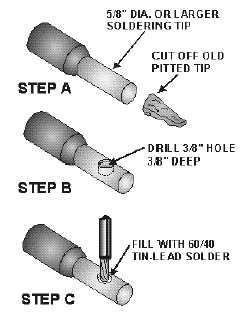2-26
WARNING
Do not shake off excess solder. It can cause serious burns if it contacts your
skin. It can also cause short circuits in exposed electrical equipment that may be in
the immediate area of the tinning operation.
CAUTION
Use only rosin flux or rosin-core solder for tinning copper wires to be used in
electrical and electronics systems. Corrosive flux will cause damage. During the
tinning operation, do not melt, scorch, or burn the insulation.
Q22. What does "tinning" mean in relationship to soldering?
Q23. Why should wire be stripped 1/32 inch longer than the depth of the solder barrel?
Q24. How much of the stripped length of a conductor should be tinned?
ALTERNATIVE DIP-TINNING PROCEDURE
If an electrically heated solder pot is not available, a small number of wires can be tinned using the
following procedure (see figure 2-26):
Figure 2-26.—Alternate dip-tinning method.
1. Cut off the beveled section of the tip of a discarded soldering iron tip.
2. Drill a hole (1/4- to 3/8-inch diameter) in the round part of the tip about two-thirds through.
3. Heat the iron and melt the rosin-core solder into the hole.
4. Tin the wires by dipping them into the molten solder one at a time.
5. Keep adding fresh rosin-core solder as the flux burns away.

